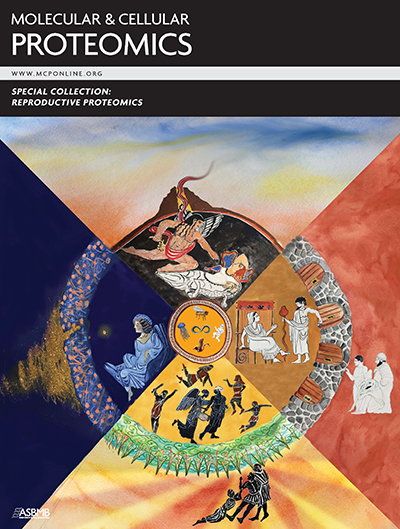MCP: A spotlight on reproductive proteomics
In a collection of articles highlighting recent discoveries in sperm and egg biology, a special issue of the journal Molecular & Cellular Proteomics celebrates the contribution of the field of proteomics to a deeper understanding of reproductive biology.
 The Molecular & Cellular Proteomics special issue cover by artist Julie Newdoll illustrates the diversity of reproductive systems in the animal kingdom.Julie Newdoll
The Molecular & Cellular Proteomics special issue cover by artist Julie Newdoll illustrates the diversity of reproductive systems in the animal kingdom.Julie Newdoll
Edited by MCP Associate Editor Tim Karr of the Biodesign Institute at Arizona State University, the issue showcases the versatility and multiplicity of proteomic technologies for analysis of protein abundance, post-translational modifications, protein–protein interactions and subcellular localization in reproduction.
According to Karr, proteomic approaches are particularly well-suited to studying reproductive biology.
“Sexual reproduction in many cases can be thought of as cellular action at a distance, that is, sperm travels outside the body in which it was produced,” Karr said. “Therefore, we can expect that a majority of interactions and interesting biology takes place predominantly at the protein–protein interaction level.”
Sperm are known to transmit packaged RNAs, but compared with somatic cells, sperm are transcriptionally inactive, further highlighting the importance of protein interactions.
Proteomics is also important in the study of interactions between the male ejaculate and the female reproductive tract. There is little experimental evidence that gene expression or other gene–gene interactions play a major role once the ejaculate is delivered to the reproductive tract.
“For these cases, proteomics is a fruitful approach if one wishes to understand the molecular mechanisms involved,” Karr said.
The special issue dives into a few major themes in reproductive biology. A series of papers investigates how proteomes of reproductive cells change throughout the reproductive processes, such as spermatogenesis, sperm maturation and capacitation, and oocyte activation.
Human fertility also is explored in depth in this special issue. A few studies delineate the proteomes of infertile sperm and sperm that undergo different abstinence periods. Another study provides the first draft map of the human ovarian proteome and its extracellular matrix, which can inform the development of artificial ovaries and provide greater understanding of fertility in women.
Two papers seek to understand polyandry, a pattern of mating in which a female animal has more than one male mate. One study investigates how polyandry drives sexual selection, and another looks to understand the protein–protein interactions that mediate sperm competition dynamics and preservation.
The special issue includes studies in various organisms, from humans to insects and even crocodiles. The diversity of organisms highlights the importance of studying reproduction. One study discovered that crocodile sperm undergo capacitation, a functional maturation that was thought to be restricted to mammals. The fact that an analogous process was observed in a distant reptilian species could challenge what we know about the evolution of species.
“Sperm and egg are the only cell types for which their function is universal throughout the animal kingdom,” Karr said. “From an evolutionary viewpoint, sperm and egg are the glue that binds life, and therefore their constituent proteomes may represent our deepest links to the evolution of eukaryotic life on the planet.”
Enjoy reading ASBMB Today?
Become a member to receive the print edition monthly and the digital edition weekly.
Learn moreGet the latest from ASBMB Today
Enter your email address, and we’ll send you a weekly email with recent articles, interviews and more.
Latest in Science
Science highlights or most popular articles

From the journals: JLR
How lipogenesis works in liver steatosis. Removing protein aggregates from stressed cells. Linking plasma lipid profiles to cardiovascular health. Read about recent papers on these topics.

Small protein plays a big role in viral battles
Nef, an HIV accessory protein, manipulates protein expression in extracellular vesicles, leading to improved understanding of HIV-1 pathogenesis.

Genetics studies have a diversity problem that researchers struggle to fix
Researchers in South Carolina are trying to build a DNA database to better understand how genetics affects health risks. But they’re struggling to recruit enough Black participants.

Scientists identify new function of learning and memory gene common to all mammalian brain cells
Findings in mice may steer search for therapies to treat brain developmental disorders in children with SYNGAP1 gene mutations.

From the journals: JBC
Biased agonism of an immune receptor. A profile of missense mutations. Cartilage affects tissue aging. Read about these recent papers.

Cows offer clues to treat human infertility
Decoding the bovine reproductive cycle may help increase the success of human IVF treatments.

